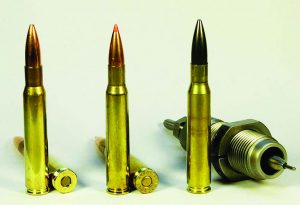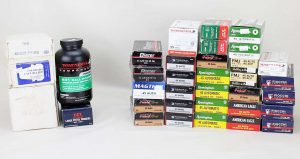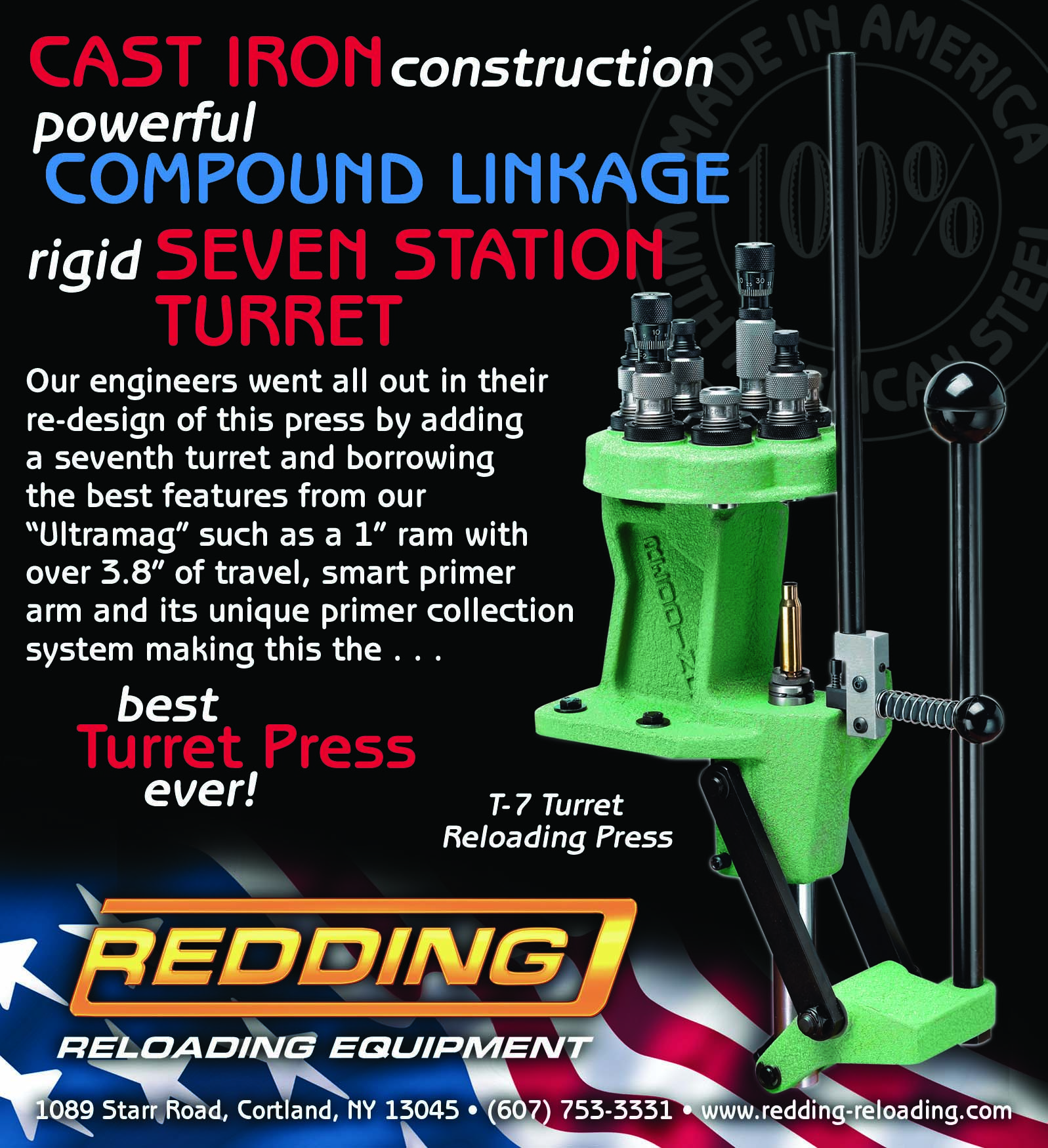by Art Merrill | Contributing Editor

Loading your own match rifle ammo costs less than half as much as top tier factory match grade ammo.(Left to Right: Creedmoor Sports, Hornady, and handload with moly coated bullet).
“Handloads are cheaper than factory loads, right?” is a question that others will inevitably ask you.
The short answer is, “Yes.” But the answer to, “How much cheaper?” depends largely on the cost of components: bullets, powder, primers and cases.
Those costs rise with inflation and any lessening availability of materials as markets fluctuate. However, those same forces impact the cost of manufacturing factory ammo, too, so some inherent price difference between factory and home rolled ammo remain. Brass cartridge cases alone present another variable that’s tricky to factor into handloading cost because that price runs from free to a couple of dollars each, and when amortizing that cost it drops with each subsequent reloading.
For a straight answer on, “How much?” let’s look at real-world-today examples, first comparing the cost of my own match grade .30-06 handloads for Vintage Military Sniper Rifle competition to today’s factory match grade stuff.
One pound of IMR 4895 powder costs $33. A box of 100 .308 caliber 175-gr. Sierra Matchking bullets runs $38, and Winchester Large Rifle primers are about $5 per 100. Of course, we will see some cost savings when buying in larger quantities — an eight pound jug of powder, a box of 500 bullets and a case of 1,000 primers — but let’s start small. The brass is already-paid-for Hornady from once-fired factory loads, which we’ll consider “free” here.
There are 7,000 grains in a pound of powder. My .30-06 load is 47-gr.; 7,000 divided by 47 is 148.9, or roughly 150 loads. Dividing $33 by 150 gives us 22¢ per load. The bullets are 38¢ each and the primers are a nickel apiece. Adding those together, a handloaded match grade cartridge costs 65¢.
Compare that to Hornady’s excellent .30-06 M1 Garand Match ammo featuring a 168-gr. A-Max bullet at $30 per box of 20, or $1.50 per round. And Creedmoor Sports is asking $1.41 per round for their fine match ammo built with Lapua components. In this apples-to-apples comparison, handloads are less than half the cost of factory ammo.
Purposing
To really understand comparative pricing we also must consider our purpose, whether that be hunting, plinking, self-defense, practice, competition or simply the pleasure of making an old gun shoot its obsolete cartridge.
The price spread for hunting ammo is similar as that for match ammo; if you’ve purchased a box of premium ammo lately, you know the days of a $12.95 box of .30-30 is way past. Walk into any well-stocked gun shop and you’ll see 20-round boxes of Weatherby ammo with three-digit price tags.
Again, let’s keep it real: a box of hunting cartridges can last us several years because we typically reconfirm last season’s zero with two or three shots and then launch one or two bullets at big game in a single season. Viewed this way, it’s more palatable to think of premium hunting ammunition costing perhaps only $10 per season rather than $42 per box.
But every autumn I see hunters at the range burn through a couple boxes of full-price hunt ammo at the bench, which pleases ammo makers but baffles my frugal nature (and while fun, is of dubious value as “practice” unless they intend to shoot elk from a bench). Whether we prefer factory hunt ammo or loading our own with premium high performance bullets, as handloaders we can make our own less-expensive practice ammo and save the premium stuff with their hi-tech hunting bullets to do their thing on game, rather than on paper.
Plinking, practice
Plinking ammo is another side of the coin, where the price difference between factory or milsurp and hand-rolled ammo can be less.
Take the 5.56 NATO as an example. A 20-round box of Mc5.56 is around $10, or 50¢ per round; milsurp in bulk gets down into the 38¢ neighborhood (though adding the cost of shipping increases the actual per-round price).

Left, $175 of handloading components (plus your fired brass) can reload about the same number of cartridges represented by the $740 of factory cartridges on the right.
When handloading, plinking quality FMJ bullets cost less than match or hunting bullets, which reduces the per-bang cost. Using the same formula as above we’ll substitute 24-gr. of Varget for the IMR loading and cap with a run-of-the-mill 18¢ FMJ bullet to load a 34¢ 5.56 cartridge. Saving four to 16 cents doesn’t seem like much until you consider how most folks shoot 5.56: rapid firing in AR-15 or other semi-auto rifles. Even at only a modest 500 rounds, handloading 5.56 plinking ammo can save $20 to $80; multiplying it by 1,000 rounds for avid shooting or competition practice doubles savings to $40 and $160.
The same applies to handgun plinking, practice and even competition ammo. I don’t remember the last time I bought a box of factory .38 Special – it’s probably been 25 years. Cast lead bullets for handguns are still a bargain, even at $80/1,000. An 8¢ bullet atop a 4¢ charge (4.3gr) of Unique started with a 5¢ primer costs 17¢ per bang. Also note that a $33 pound can of Unique will yield an impressive 1,628 cartridges at 4.3gr each. And the cost of lead bullets drops even more when you cast your own.
Self-defense
You’ve noticed the trend in manufacturers packaging 20 or 25 rounds of premium defensive handgun ammo at the same cost as a 50-round box of non-defense ammo. You can do the math. The cost difference between these specialized rounds and loading your own JHP cartridges is about like that of premium hunting ammo vs handloads.
Comparing Costs
Handloaded cartridges are less than half the cost of comparable factory cartridges. Using the .38 Special as an example, we can handload more than 1,600 rounds for less than half the cost of the cheapest factory ammo.
One pound of Unique: $33
1,628 lead bullets: $130
1,628 primers: $81
TOTAL: $211Box of 50 factory LRN .38 Spec cartridges: $15
1,628 rounds ÷ 50 per box = 32.5 boxes
32.5 boxes x $15
TOTAL: $488
However, there’s far more at stake — such as proven, dependable, one-shot stopping performance and potential post-shooting legal entanglements —in self-defense matters than we’ll ever confront in recreational shooting. My personal choice is to buy, rather than load self-defense carry ammo. That’s grist for a different conversation.
Tool amortizing
Now we come to the part where we amortize the cost of our handloading press and other tools into the cost of handloading. That’s a tough one because that cost differs radically for each of us. Sometimes we pay full price, sometimes we receive handloading tools as gifts, sometimes we find bargains. Regardless, the more we handload the more that cost reduces. If we spend $250 on tools to load one individual cartridge, that’s a mighty expensive cartridge; if we load 50,000 cartridges over decades, that tooling cost nearly vanishes to $.005 per cartridge while the cost of factory ammo inevitably rises.
Let’s also point out that, unlike our expensive electronic gadgets, most handloading tools are forever. A press, die set and balance beam scale are one-time purchases that will outlive us. If you can forebear cable TV for six months, you’ll have saved enough money to buy all the tools needed for handloading a couple of different cartridges for the rest of your life.
That said, the reality is that most of us load far more than two flavors of cartridge; instead, we sit at a handloading buffet without limits other than those we impose on ourselves. Also, because homemade ammo costs less than packaged stuff, handloaders probably tend to shoot more, so our theoretical savings just go down the bore anyway. So, for many handloaders it isn’t about saving money, it’s about shooting more for the same cost.
And nobody becomes a better shooter by shooting less.




